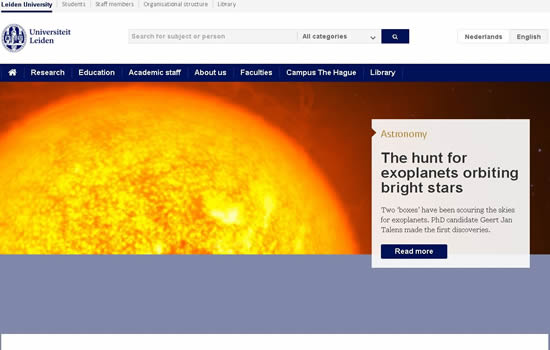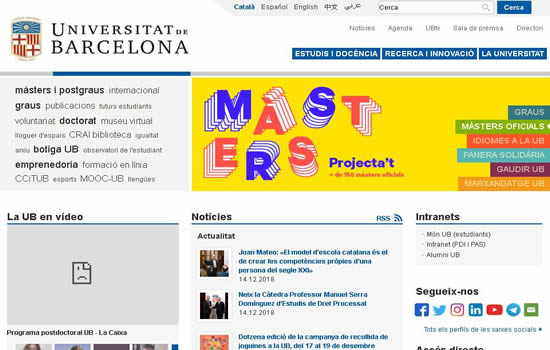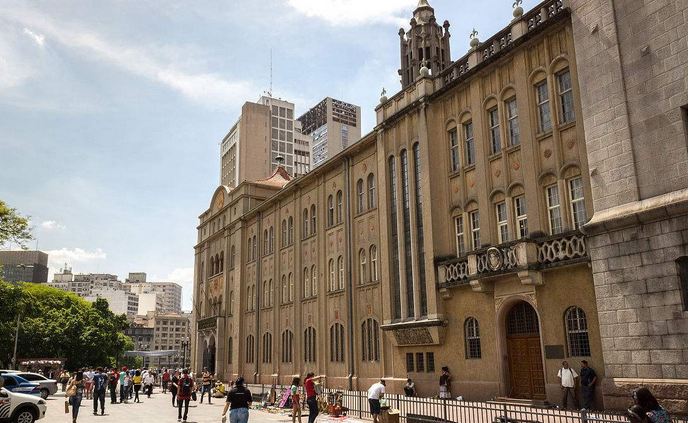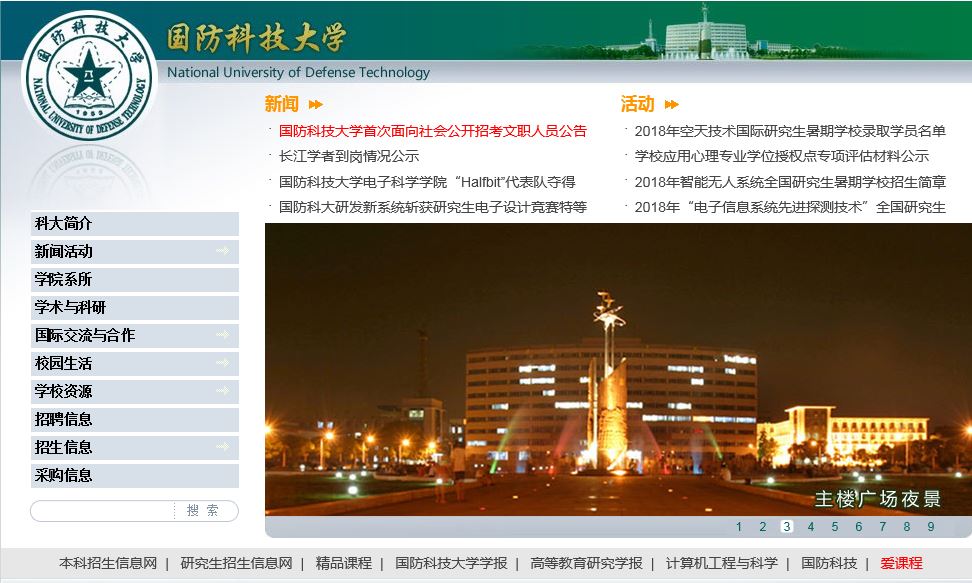选择热点
 荷兰莱顿大学
荷兰莱顿大学 西班牙巴塞罗那大学
西班牙巴塞罗那大学 巴西圣保罗大学 University of Sao Paulo, Brazil
巴西圣保罗大学 University of Sao Paulo, Brazil 台湾南华大学 University of South China in Taiwan
台湾南华大学 University of South China in Taiwan 科技大学 National University of Defense Technology
科技大学 National University of Defense Technology 南京大学 Nanjing University
南京大学 Nanjing University 上海复旦大学 Fudan University
上海复旦大学 Fudan University 泗水大学(Ubaya)
泗水大学(Ubaya) 印尼大学 universitas indonesia
印尼大学 universitas indonesia 越南某大学 Vietnam National University
越南某大学 Vietnam National University 菲律宾大学 University Of The Philippines
菲律宾大学 University Of The Philippines
加利福尼亚的科学家们制造了一台照相机来拍摄大片的天空
发布时间:2025-01-06
来源:大学网站
California Scientists Build A Camera To Take Pictures Of Huge Swath Of Sky加利福尼亚的科学家们制造了一台照相机来拍摄大片的天空Romanesco broccoli, as seen by a 3.
2 billion pixel camera.
Scientists chose to take a picture of the broccoli because of its fractal shape.
用32亿像素的摄像头拍摄的罗马花椰菜。
科学家之所以选择给花椰菜拍照,是因为它的分形形状。
Scientists and engineers in California are building a unique camera for a unique telescope.
加利福尼亚的科学家和工程师们正在为一台独特的望远镜制造一个独特的照相机。
The Rubin Observatory telescope going up on Cerro Pachón in north-central Chile can capture an unusually large swath of sky in a single image.
鲁宾天文台的望远镜在智利中北部的塞罗帕肯上,可以在一张图片中捕捉到一大片不同寻常的天空。
The camera capable of capturing those images has to be enormous.
The one researchers are building at the SLAC National Accelerator Laboratory in Menlo Park, Calif.
, certainly is.
能够捕捉到这些图像的照相机必须是巨大的。
研究人员正在加州门洛帕克的SLAC国家加速器实验室里建造的这个当然就是(巨大的)。
"The whole camera is about 13 feet from the front lens to the back where we have all our support equipment, and the 5 feet in diameter--so, massive," says Aaron Roodman, the scientist in charge of assembling and testing the camera.
负责组装和测试相机的科学家亚伦·鲁德曼说:整个相机从前镜头到后镜头大约13英尺,我们有所有的辅助设备都在这里,直径5英尺,非常大。
”。
Inside the camera are lenses, filters, cables, refrigeration equipment, and a focal plane consisting of 189 detectors capable of taking 3.
2 billion pixel image.
The refrigeration is needed to chill the detectors to their operating temperature of negative 150 degrees Fahrenheit.
相机内部有镜头、滤镜、电缆、制冷设备和由189个探测器组成的焦平面,这些探测器能够拍摄32亿像素的图像。
需要制冷装置将探测器冷却到零下150华氏度的工作温度。
It's not a camera you can throw together in your garage.
"Oh boy, no, no," Roodman replies.
"Definitely not.
"它不是一款可以放在车库里的相机。
哦,天哪,不,不,”鲁德曼回答。
绝对不会。
”When it's fully assembled, a series of lenses will help focus the light from celestial objects.
Roodman says he and his colleagues wanted a way to project an image onto the detectors in the focal plane that wouldn't need lenses to be in focus.
当它完全组装好后,一系列的镜头将帮助聚焦来自天体的光线。
鲁德曼说,他和他的同事想找到一种方法,将图像投射到焦平面的探测器上,这样就不需要透镜聚焦了。
"So I invented a little thing I call a pinhole projector," he says.
"Basically a metal box with a tiny pinhole at the top of it, and lights inside the box.
"所以我发明了一种叫做针孔投影仪的小东西,”他说基本上是一个顶部有一个小孔的金属盒子,盒子里有灯。
”The image of whatever is in the box will be projected into the camera's detectors.
盒子里的物体的图像将投射到照相机的探测器中。
But what to project for a test?
They started by putting various images into the projector, including a picture of Vera Rubin, the astronomer after whom the telescope is named.
但是要做什么测试呢?
他们开始将各种图像放入投影仪中,包括一张维拉·鲁宾的照片,望远镜就是以这位天文学家的名字命名的。
But then they wanted something a bit more optically challenging, so they decided on Brassica oleracea, the kind known as Romanesco broccoli.
但后来他们又想要一些在光学上更具挑战性的东西,于是他们决定选择甘蓝,也就是罗马花椰菜。
Why broccoli?
为什么选择花椰菜?
"Mostly for fun," Roodman says.
"It has an interesting fractal structure, and we thought it would look cool, which I think it does.
"主要是为了好玩,”鲁德曼说。
它有一个有趣的分形结构,我们认为它看起来会很酷,我认为确实如此。
”The broccoli picture assured them the detectors were working as intended.
西兰花的图片让他们确信探测器正在按计划工作。
COVID-19 has delayed the completion of the camera.
COVID-19延误了相机的完成。
Roodman says they're still hoping to finish it in time to get it to Chile and installed in telescope by the fall of 2022, where it can be used to search the sky for interesting celestial objects.
鲁德曼说,他们仍然希望能及时完成,并在2022年秋天将其送到智利,安装在望远镜中,用于在天空中寻找有趣的天体。
【加利福尼亚的科学家们制造了一台照相机来拍摄大片的天空查看网站:[db:时间]】
2 billion pixel camera.
Scientists chose to take a picture of the broccoli because of its fractal shape.
用32亿像素的摄像头拍摄的罗马花椰菜。
科学家之所以选择给花椰菜拍照,是因为它的分形形状。
Scientists and engineers in California are building a unique camera for a unique telescope.
加利福尼亚的科学家和工程师们正在为一台独特的望远镜制造一个独特的照相机。
The Rubin Observatory telescope going up on Cerro Pachón in north-central Chile can capture an unusually large swath of sky in a single image.
鲁宾天文台的望远镜在智利中北部的塞罗帕肯上,可以在一张图片中捕捉到一大片不同寻常的天空。
The camera capable of capturing those images has to be enormous.
The one researchers are building at the SLAC National Accelerator Laboratory in Menlo Park, Calif.
, certainly is.
能够捕捉到这些图像的照相机必须是巨大的。
研究人员正在加州门洛帕克的SLAC国家加速器实验室里建造的这个当然就是(巨大的)。
"The whole camera is about 13 feet from the front lens to the back where we have all our support equipment, and the 5 feet in diameter--so, massive," says Aaron Roodman, the scientist in charge of assembling and testing the camera.
负责组装和测试相机的科学家亚伦·鲁德曼说:整个相机从前镜头到后镜头大约13英尺,我们有所有的辅助设备都在这里,直径5英尺,非常大。
”。
Inside the camera are lenses, filters, cables, refrigeration equipment, and a focal plane consisting of 189 detectors capable of taking 3.
2 billion pixel image.
The refrigeration is needed to chill the detectors to their operating temperature of negative 150 degrees Fahrenheit.
相机内部有镜头、滤镜、电缆、制冷设备和由189个探测器组成的焦平面,这些探测器能够拍摄32亿像素的图像。
需要制冷装置将探测器冷却到零下150华氏度的工作温度。
It's not a camera you can throw together in your garage.
"Oh boy, no, no," Roodman replies.
"Definitely not.
"它不是一款可以放在车库里的相机。
哦,天哪,不,不,”鲁德曼回答。
绝对不会。
”When it's fully assembled, a series of lenses will help focus the light from celestial objects.
Roodman says he and his colleagues wanted a way to project an image onto the detectors in the focal plane that wouldn't need lenses to be in focus.
当它完全组装好后,一系列的镜头将帮助聚焦来自天体的光线。
鲁德曼说,他和他的同事想找到一种方法,将图像投射到焦平面的探测器上,这样就不需要透镜聚焦了。
"So I invented a little thing I call a pinhole projector," he says.
"Basically a metal box with a tiny pinhole at the top of it, and lights inside the box.
"所以我发明了一种叫做针孔投影仪的小东西,”他说基本上是一个顶部有一个小孔的金属盒子,盒子里有灯。
”The image of whatever is in the box will be projected into the camera's detectors.
盒子里的物体的图像将投射到照相机的探测器中。
But what to project for a test?
They started by putting various images into the projector, including a picture of Vera Rubin, the astronomer after whom the telescope is named.
但是要做什么测试呢?
他们开始将各种图像放入投影仪中,包括一张维拉·鲁宾的照片,望远镜就是以这位天文学家的名字命名的。
But then they wanted something a bit more optically challenging, so they decided on Brassica oleracea, the kind known as Romanesco broccoli.
但后来他们又想要一些在光学上更具挑战性的东西,于是他们决定选择甘蓝,也就是罗马花椰菜。
Why broccoli?
为什么选择花椰菜?
"Mostly for fun," Roodman says.
"It has an interesting fractal structure, and we thought it would look cool, which I think it does.
"主要是为了好玩,”鲁德曼说。
它有一个有趣的分形结构,我们认为它看起来会很酷,我认为确实如此。
”The broccoli picture assured them the detectors were working as intended.
西兰花的图片让他们确信探测器正在按计划工作。
COVID-19 has delayed the completion of the camera.
COVID-19延误了相机的完成。
Roodman says they're still hoping to finish it in time to get it to Chile and installed in telescope by the fall of 2022, where it can be used to search the sky for interesting celestial objects.
鲁德曼说,他们仍然希望能及时完成,并在2022年秋天将其送到智利,安装在望远镜中,用于在天空中寻找有趣的天体。
【加利福尼亚的科学家们制造了一台照相机来拍摄大片的天空查看网站:[db:时间]】
- 上一篇: “史无前例”的野火季节威胁着加州的葡萄酒产区
- 下一篇: 欧盟欲向科技巨头发难
相关阅读
目录列表
资讯列表
英语资讯


共0条评论
网友评论温馨提示:您的评论需要经过审核才能显示,请文明发言!